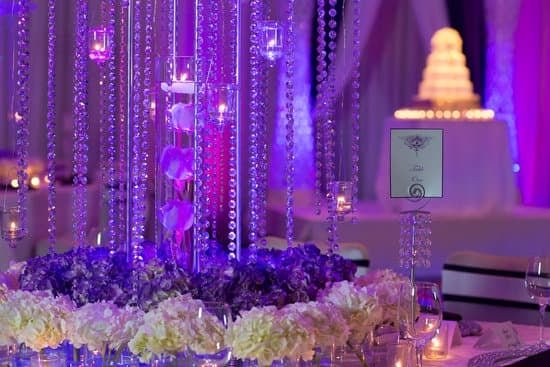Flowers are an essential element of weddings, adding beauty, fragrance, and symbolism to the special day. The question of who pays for the flowers in a wedding is a topic that has long been a source of debate and confusion.
As couples navigate the complexities of planning their special day, understanding traditional customs and modern trends regarding floral expenses is crucial. In this article, we will explore the significance of flowers in a wedding and delve into the age-old question: who foots the bill for these beautiful blooms?
Wedding flowers have played a significant role in ceremonies throughout history, with each bloom carrying its own symbolic meaning. From the bride’s bouquet to the floral décor at the ceremony and reception, flowers serve as a visual expression of love, joy, and new beginnings. As we embark on our exploration of flower expenses in weddings, it is important to understand the cultural and traditional significance of these botanical adornments.
Traditionally, there have been established expectations regarding who covers the cost of wedding flowers. The bride’s family has historically taken on this responsibility as part of their contribution to the wedding festivities. However, as societal norms continue to change and evolve, so too do the dynamics surrounding financial responsibilities for floral arrangements at weddings. Join us as we unravel the customs and etiquette related to who traditionally pays for wedding flowers and how these roles have transformed over time.
Traditional Wedding Flower Expenses
In traditional wedding etiquette, the responsibility for paying for the wedding flowers often fell on the bride’s family. Historically, it was considered a part of the bride’s family’s contribution to the overall cost of the wedding.
This tradition stemmed from the idea that the bride’s family was responsible for hosting and providing for the ceremony and reception. As a result, they were also expected to cover the expenses associated with floral arrangements, including bouquets, boutonnieres, centerpieces, and other decorative elements.
In addition to covering the cost of wedding flowers, it was also common for the bride’s family to take care of other aspects of the wedding, such as catering, venue rentals, and entertainment. This tradition reflected gender roles and societal norms that placed a greater financial burden on the bride’s family when it came to hosting a wedding.
However, in modern times, this traditional division of financial responsibilities has shifted significantly. While some families may still adhere to these customs, many couples are now opting to share or cover their own wedding flower expenses. The changing dynamics of who pays for what in a wedding reflect evolving social norms and financial independence among couples today.
| Wedding Flower Expense Responsibility | Description |
|---|---|
| Bride’s Family | Historically responsible for covering the cost of wedding flowers as part of their contribution to hosting and providing for the ceremony. |
| Groom’s Family | May contribute financially to floral arrangements as part of their role in supporting their son’s marriage. |
| The Couple | Increasingly becoming common for couples to share or cover their own wedding flower expenses due to shifting societal norms and financial independence. |
Bride’s Family’s Responsibility
The tradition of the bride’s family covering the cost of wedding flowers dates back many centuries, and it is deeply rooted in historical customs and social expectations. In the past, weddings were seen as an event organized by the bride’s family, and they were responsible for all associated expenses, including the floral arrangements.
This practice was a symbol of the bride’s family’s willingness to welcome the groom into their household and to support the couple as they embarked on their new life together.
Furthermore, wedding flowers were not just decorative elements but also held symbolic importance. They were used to convey messages and sentiments, with each type of flower carrying its own meaning. As such, meticulous care was taken in selecting and arranging the flowers to create a beautiful and meaningful atmosphere for the wedding ceremony.
In addition to being a traditional responsibility, covering the cost of wedding flowers was also considered a demonstration of financial stability and social status. The ability of the bride’s family to afford elaborate floral arrangements was often seen as a reflection of their wealth and standing in society. This further reinforced the expectation that it was the bride’s family who should pay for these essential elements of the wedding celebration.
| Historical Tradition | Bride’s Family |
|---|---|
| Deeply rooted in historical customs | Responsible for all wedding expenses |
| Symbolic importance of wedding flowers | Demonstration of financial stability |
Groom’s Family’s Responsibility
The role of the groom’s family in contributing to the floral arrangements for a wedding has been a traditional expectation in many cultures. In the past, it was customary for the groom’s family to take on some of the financial responsibilities associated with the wedding, including the cost of flowers. This would typically include the expense of the bride’s bouquet, as well as flowers for the ceremony and reception.
Historical Tradition and Expectations
In many traditional weddings, it was expected that the groom’s family would cover specific flower expenses. This tradition stems from a time when weddings were often seen as more of a financial burden on the bride’s family, and as a result, the groom’s family would step in to contribute financially to certain aspects of the wedding, including floral arrangements.
Changing Dynamics
As societal norms have shifted over time, so have expectations regarding who pays for what in a wedding. In modern times, it is not uncommon for the couple themselves to take on more responsibility for covering wedding expenses, including flowers. This shift away from traditional gender roles and family dynamics has led to greater flexibility in how wedding expenses are handled.
Navigating Expectations
When it comes to determining who pays for the flowers in a wedding, open communication among both families and the couple is crucial. It is important for all parties involved to discuss their expectations and come to an agreement on how expenses will be managed. Ultimately, every wedding is unique, and what matters most is that all parties feel comfortable with their respective roles in contributing to make your event special”.
Modern Wedding Flower Expenses
In modern times, the traditional norms and expectations surrounding who pays for the flowers in a wedding have evolved. The financial responsibility for wedding flowers is no longer exclusively placed on one party, but rather shared among various contributors. As society has shifted towards more egalitarian values and financial independence, couples are increasingly taking on the responsibility of covering the cost of their own wedding flowers.
To understand the changing landscape of modern wedding flower expenses, it is essential to consider the evolving social norms that have influenced this shift. In the past, it was customary for the bride’s family to bear the burden of paying for all of the wedding expenses, including the floral arrangements. However, as individuals are delaying marriage until later in life and becoming financially independent before tying the knot, this tradition has become less common.
With couples often financing their own weddings, many choose to allocate a portion of their budget specifically for floral decorations. This allows them to have more control over their wedding aesthetic and select flower arrangements that reflect their personal style and vision for their big day. Additionally, some couples opt to include contributions from both families or seek assistance from other sources to cover the costs of their wedding flowers.
The Couple’s Responsibility
When it comes to wedding expenses, the tradition of the bride’s family shouldering the cost has evolved over time. In modern weddings, it is becoming increasingly common for the couple themselves to take on financial responsibilities, including contributing to the cost of wedding flowers. This shift can be attributed to various factors and has implications for both the couple and their families.
Rationale for Couples Sharing Financial Responsibility
Couples are choosing to share in the financial burden of wedding expenses, including flowers, for several reasons. One explanation for this trend is that weddings are becoming more personalized and reflective of the couple’s unique taste and style. As a result, couples may opt to have a say in floral arrangements that align with their preferences, leading them to contribute financially towards these choices.
Another consideration is that many couples today are establishing their lives together before marriage, often living independently and managing their own finances. This financial independence can lead to a shared responsibility for wedding costs, including flowers.
Implications of Couples Sharing Financial Responsibility
The decision for couples to contribute towards wedding flower expenses can have implications beyond just sharing the financial burden. It signifies a shift in traditional gender roles and expectations within relationships. By sharing in the financial responsibilities, couples are signaling equality and partnership in their decision-making process.
Additionally, this shift may also impact familial dynamics as it sets a precedent for how future financial decisions will be made within the couple’s relationship. It may influence how each partner interacts with their respective families regarding contributions towards wedding expenses, shaping future familial relationships as well.
As weddings continue to evolve alongside societal norms and values, it’s clear that who pays for the flowers in a wedding is not simply a matter of tradition or etiquette but rather reflects broader shifts in attitudes towards marriage and family dynamics.
Other Potential Contributors
When it comes to who pays for the flowers in a wedding, there are other potential contributors beyond the immediate families of the bride and groom. In modern times, the financial burden of wedding expenses is often shared among various individuals and sources. Here are some potential contributors to consider:
- The wedding party: It is not uncommon for members of the wedding party, such as bridesmaids and groomsmen, to offer to contribute to the cost of wedding flowers. Whether it’s a financial contribution or taking on specific tasks related to floral arrangements, the bridal party can play a role in helping cover these expenses.
- Close friends: Close friends of the couple may also want to contribute to the cost of wedding flowers as a way to show their support and help alleviate some of the financial burden. They may offer to cover specific aspects of floral arrangements, such as bouquets or centerpieces, or provide financial assistance towards overall floral costs.
- The couple themselves: With many couples choosing to take on more responsibility for financing their own weddings, it’s becoming increasingly common for them to pay for their own wedding flowers. This shift reflects a desire for greater independence and control over all aspects of their special day, including floral arrangements.
In today’s weddings, there are numerous potential contributors who may offer to help cover the cost of wedding flowers. By involving other individuals and sources in financing floral arrangements, couples can alleviate some of the financial burden traditionally shouldered by their families. This collaborative approach reflects changing social norms surrounding marriage and showcases a collective effort in making the celebration truly special.
Conclusion
In conclusion, the question of who pays for the flowers in a wedding is a complex and evolving issue, influenced by traditional etiquette, cultural customs, and modern social norms. While historically, it was the bride’s family’s responsibility to cover the cost of wedding flowers, times have changed, and the financial burden is increasingly being shared among various contributors.
As we navigate this often intricate matter, it is important for couples to communicate openly with their families about their expectations and preferences regarding floral arrangements for their big day.
In today’s world, it has become increasingly common for the couple to take on the responsibility of paying for their own wedding flowers. This shift marks a departure from traditional norms and reflects a more modern approach to wedding planning.
Furthermore, with the rise of non-traditional and personalized weddings, many couples are choosing to allocate their budget towards other aspects of their special day, such as food or entertainment, rather than investing heavily in floral decor. Ultimately, how the cost of wedding flowers is divided among different parties will depend on individual circumstances and personal choices.
As we look to the future of wedding traditions and customs, it is important for couples and their families to approach discussions about who pays for the flowers with understanding and flexibility. Whether it is the bride’s family, groom’s family, or even close friends who ultimately contribute to this aspect of the wedding expenses, what matters most is that love and support are at the heart of this meaningful celebration.
Frequently Asked Questions
What Is the Groom’s Family Supposed to Pay For?
The groom’s family is traditionally expected to pay for specific expenses related to the wedding, such as the rehearsal dinner, the officiant’s fee, the marriage license, and sometimes the alcohol for the reception.
What Flowers Does Groom Pay For?
The groom typically pays for the bride’s bouquet, corsages for his mother and hers, boutonnieres for himself and his groomsmen, as well as any other floral arrangements specifically related to the groom’s side of the wedding party.
Which Family Pays for the Flowers at a Wedding?
In some cultures or traditions, it is common for both the bride’s and groom’s family to contribute to the cost of flowers at a wedding. However, in most cases in Western weddings, it is customary for the bride’s family to cover the expenses related to floral arrangements for both sides of the ceremony and reception.

I have been involved in marriages for over 20 years helping couples and singles understand more about them.





